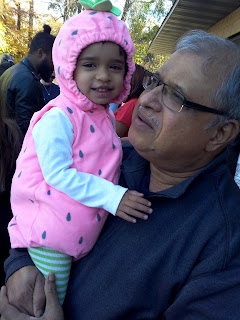Remembering ancestors, celebrating harvest time and involving children through various activities during these events is a practice followed in all parts of the world. The name and form of the celebrations may differ from place to place and among societies; the essence and spirit of the festivals and the pleasures sought through them are the same everywhere.
In our country, the fortnight after Ganesh festival, second half of Bhadrapad month, is earmarked for remembering the ancestors. Families have a day for performing rituals of the deceased ancestors, as per family practices. The last day of the fortnight (New Moon Day), known as Mahalaya Amavasya, is widely celebrated among all sections as Sarva Pitru Amavasya. This is the time for all relatives to get together in one place, pay tributes to the ancestors and have a grand lunch together. In fact, the period of Navaratri or Dusserah starts immediately after Mahalaya Amavasya.
*****
Halloween festival observed in Europe, America and other parts of the world is also connected with remembering ancestors and involving children in the celebrations. It is observed on October 31st every year and dedicated to remembering the ancestors and all departed including saints, martyrs and all faithfuls. It's full name is All Hallows' Eve or All Saint's Eve and it is also deemed a harvest festival. Halloween arrives just before winter months. The festival has gained prominence from early 17th century and also said to mean Hallowed evening or Holy evening. Celebration practices include decoration of houses specially for the occasion with lighting and red pumpkins. Lights are used inside carved pumpkins and displayed in front of the houses. Pumpkin carving is itself an art and shops and malls display a variety of carved pumpkins days before the festival. Lanterns are also associated with the festival and there is a story of Jack-O-Lantern representing souls denied entry in both Heaven and Hell (Antara pishachi?).
In addition to decorating houses with pumpkins and lights, other celebration practices include attending special church mass services and lighting candles on the graves of the dead. Arranging Halloween costume parties is another popular phase of the festival. All participants including elders dress in special costumes for these parties. Families visit shops and malls for buying the costumes and pumpkin lights days before the event. On the evening of Halloween Day, children dressed in Halloween costumes and carrying Halloween bags go from house to house in the locality with the basic activity of "Trick or Treat?". The phrase "Trick or Treat" represents the children asking house owners whether they should carry out some trick on their property (meaning bringing some damage to it) or the house owners settle for a treat by way of offering candies to them! Households keep candies, chocolates and similar items and offer to the children coming to their houses dressed in various costumes. Children have a large collection of assorted candies at the end of the rounds on the Halloween night.
Our experience with Halloween during our earlier visits to USA was confined to decorating the house and offering candies to children on their rounds in the evening. This year it was extended further with one child in our own household making the "Trick or Trade" rounds. There were visits to the malls for purchase of carved pumpkin lights and Halloween dresses. We were also invited to a "Halloween Parade" in the school where all the children and teachers were present in Halloween costumes. The parade was followed by serving of refreshments to the participating children and visitors like us alike. In the evening, we had the pleasure of offering candies to children coming on "Trick or Treat" rounds and moving around with our participant in the rounds. We ourselves did not participate in any Halloween party in special costumes. May be that may have to wait for sometime later!
Halloween celebrations have many things in common with our own Mahalaya Amavasya and Navaratri/Dusserah. Halloween also signals the beginning of three months of celebrations - Thanksgiving day in November and Christmas in December and through to a new year on January first of the next calendar year.




Very nicely narrated Halloween event. Great picture of Grandfather and Grand daughter........UR
ReplyDeleteNice article. Very well related. Your photo with your GD is very good.
ReplyDeleteHappy Deepavali to you and all the members of your family.
Bharath
Nice article. Very well related. Your photo with your GD is very nice.
ReplyDeleteWish you and all the family members of your family a very happy Deepavali.
Bharath
Very fine narration. It made me to remember my visit to USA and the said Halloween celebrations. It is very much enjoyed by the childern.
ReplyDeleteVery well narrated story about Halloween. I always wondered what it was all about.
ReplyDeleteFestivals are all about joy and socialising one way or the other while keeping the children informed about customs and traditions. World over, the purpose of festivals is about amity and friendship.
Very nice narration.All over the world ancestors are r ember ed during a particular period as in India.
ReplyDeleteHalloween narration is fantastic.
ReplyDeleteR Jagannathan
BMSB
very nice observation .Great indeed
ReplyDeleteWhen I was told about Halloween festival I was keen to know about why and how the festival is celebrated. Nice presentation. Thanks for the same. You must have enjoyed along with the participant from your home.
ReplyDeleteGood insight on Halloween. A nice read. Thanks Keshavmurthy, Sir.
ReplyDeleteGood narration and relating the events like linking first generation and third generation as you posted the photograph. Seasons greetings
ReplyDeletei am convinced that any festival any where in the world is directly related to seasons of nature. And the real reason for these seasonal festivals are to rejoice the nature with friends and relatives. Nicely narrated the holloween's day celebration likening with hindu festival mahalaya amavasye. Great Sir.
ReplyDeletevery enjoyable reading as always.
ReplyDelete